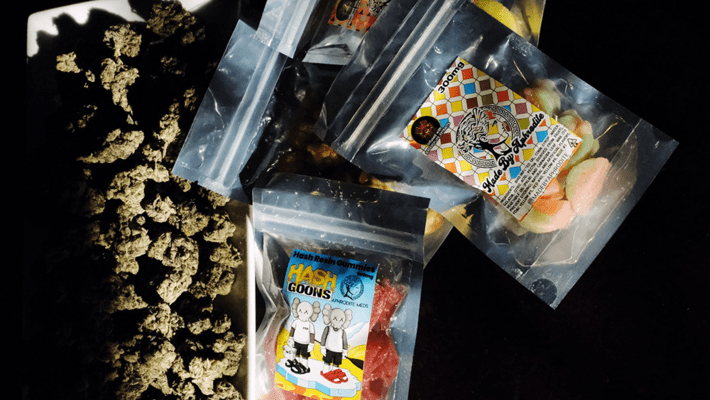
How has Cannabis Packaging Evolved?
Published on 2/10/21
The cannabis market in the U.S. continues to grow at a rapid clip. A total of 36 states, including the District of Columbia, Guam, Puerto Rico and the U.S. Virgin Islands, have legalized medical marijuana and 15 states have approved recreational weed for adult use. The increase in the market size and laws in states joining the legalization movement means that cannabis brands are constantly looking to improve the packaging of cannabis products to both remain compliant and be attractive to consumers.
Marijuana Packaging Gets Regulated
 Pexels
PexelsThe "good old days" of plastic weed baggies of shake, a bud wrapped in tinfoil or a film canister of marijuana are thankfully long gone. Before legalizing recreational marijuana in 2012, the State of Colorado realized that children can typically open regular packaging and decided to establish a code. Based on the Federal Drug Administration's child-resistant regulations, this code mandates that marijuana packages are tamper-resistant yet still simple to open for seniors and people with disabilities. These guidelines originated with the 1970 Poison Prevention Packaging Act and help prevent any accidental ingestion of cannabis products by children, which is critical to the cannabis industry's safety and reputation. After Prop 64 passed in 2016, California cannabis packaging also developed quickly and now has several requirements, updated as the industry progresses. Weed containers in the Golden State must be:
- Child-resistant
- Tamper-evident
- Resealable (if intended for multiple uses)
On the flip side, cannabis packaging may not:
- Be attractive to children
- Make health claims
- Use the word "organic" in violation of any state or federal laws
- Use the name of any county in the state except when the cannabis was 100% grown in that county
 Unsplash
UnsplashThe laws in Colorado and California set the standard for cannabis packaging and states that legalized more recently often use this as the basis of their regulations.
States like Alaska require warning statements printed on the container, similar to those for alcohol and nicotine: "Marijuana has intoxicating effects and may be habit-forming and addictive. Marijuana impairs concentration, coordination, and judgment. Do not operate a vehicle or machinery under its influence. There are health risks associated with the consumption of marijuana. For use only by adults twenty-one and older. Keep out of the reach of children. Marijuana should not be used by women who are pregnant or breastfeeding."
Arizona requires a similar notice, but must also indicate where the cannabis was cultivated, how the dispensary obtained it, along with the amount, strain and corresponding batch number. Additionally, Arizona requires that edibles contain a complete ingredient list along with food allergen information and comprehensive nutrition labeling.
Other states, like Maine, do not allow labels or packaging that depicts a human, animal or fruit for marijuana. While in Nevada, containers must be a certain thickness if used to sell marijuana.
Elsewhere, Oregon-based sellers must note if growers used pesticides on the plants, and concentrate packaging must report whether the product contains any ingredients that are not derived from cannabis.
Cannabis Packaging and the Developing Industry
 Unsplash
UnsplashWhile safety and compliance are the most important factors in marijuana packaging, there are several other aspects that manufacturers have latched on to make their product as appealing as possible in the increasingly crowded marketplace. Most stem from a marketing base, as the cannabis industry faces severe advertising restrictions and customized packaging is one of the few options available to legally market marijuana and marijuana-based consumables.
Improved Cannabis Branding
Cannabis brands use innovative design, graphics and packaging structure to attract target customers. Entire marketing firms have sprung up solely to craft attractive copy and create dazzling graphics to catch the eye of dispensary consumers.
Eco-Friendly Packaging
The cannabis world got waste-heavy (read: a LOT of plastic) very rapidly. Companies have developed and continue to develop bio-degradable, recyclable or multi-use containers to reduce the industry's environmental impact.
Enhanced Descriptions
Instead of simply following the state regulations with technical specifications of the product, marijuana packages now contain information on how the product will affect the user and in what scenarios the marijuana product might be best enjoyed.
Airtight Containers
 @n2packagingsystems via Instagram
@n2packagingsystems via InstagramWith any top-quality product that can age, storage is critical. Marijuana is no different. Nitrogen-sealed weed packaging is a relatively new way to keep cannabis fresh and prevent it from breaking down. This packaging uses a pouch or can and fills the package with nitrogen instead of oxygen.
Luxury Offerings
The popularity and ubiquitous nature of weed means that those who have the means want to flaunt their consumption. The result? Pricey designer packaging that provides an alluring tactile experience and looks unlike anything else on the market.
Do you have a favorite type of 420 packaging? What brands make the most attractive products in your opinion? Let us know in the comments section below.
